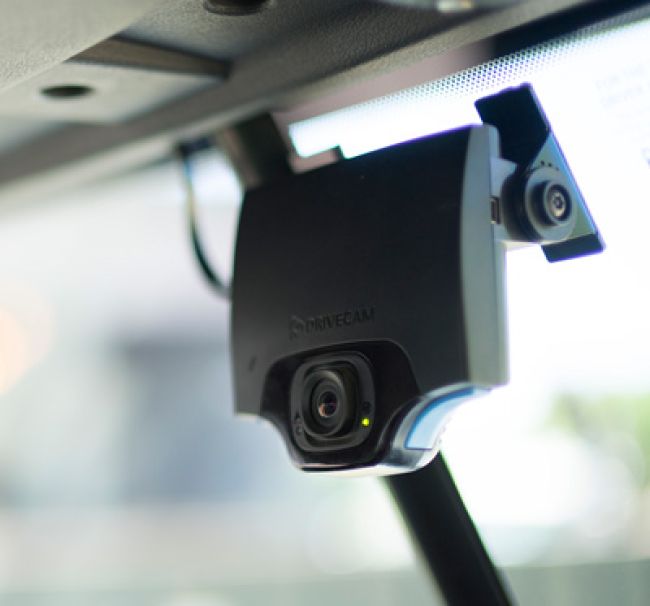
The Pros and Cons of Driver-Facing Cameras in Utility Fleets
In-cab cameras have gained a foothold and acceptance among numerous service and freight delivery fleets for the technology’s ability to improve safety and lower accident and claim costs.
Utilities, however, perhaps because of their different operational model and high system costs, appear to be relying on more traditional methods to manage risk and improve driver skills. In calls to six electric utilities across the U.S., only one – National Grid, which provides electric and gas delivery in New York, Massachusetts and Rhode Island – is using the technology as of press time.
National Grid uses about 3,600 recorders fleet-wide. For Frank Prost, director of downstate gas construction, the 316 units in his department’s trucks have worked as advertised: They’ve helped to boost safety by improving driver skills, assigning accountability and preventing accidents.
The group has seen a significant improvement in driving, according to Prost. “We’re in a much, much better place with our driving,” he said. “It’s a safer environment for employees and the public. [The cameras have] helped us numerous times. We’d get complaints about incidents but didn’t have any proof. If there’s an event, now you have a video telling us what the driver was doing. Now you can prove it.”
The cameras also have all but eliminated backing-up insurance scams, Prost said. People would intentionally back into a National Grid truck at a traffic light and claim the driver hit them. Now, drivers can get out of their truck, point to the camera and say that the video will show the truth. “The people drive off,” he said.
More typical of the utilities contacted is Ameren Missouri’s approach. “We use driver training to mitigate accidents and improve driver skills,” said Steve Hampton, director of fleet services for the St. Louis-based utility.
Understanding Resistance
One reason for the lack of acceptance of in-cab cameras may simply be the operational model; utility trucks spend less time moving and more time on-site than other fleet operations, so traditional coaching methods and training seem to work. Combine that with the costs of the technology – $100 or more per unit plus monthly subscription fees, depending on the service and supplier – and showing a return on the investment can be difficult.
There’s also an issue of union resistance to the cameras, said Jeff Stoker, president of Safety Track (www.safetytrack.net), a national wholesaler and direct supplier of fleet and asset tracking based in Belleville, Mich. “There’s a lot of pushback when unions are involved,” he said.
Del Lisk, vice president of safety services with San Diego-based Lytx DriveCam (www.lytx.com), said Lytx has a different pricing model for utilities, but he would not discuss pricing except to say that it’s a subscription base.
In the typical system, cameras are positioned in the cab and continually record both in front of the vehicle and the driver’s actions. The systems have sensors that are triggered whenever there is an event, such as hard braking, a sharp turn, speeding or any of several customer-set situations. The system will automatically save a video of several seconds before and after the event and then either upload the data to a server or save it to an SD card for downloading later, or both.
At Lytx, videos are automatically uploaded to the supplier’s system, where they are reviewed. The customer is notified if any are deemed “actionable,” Lisk said.
“We’re reviewing about 2 million video clips a month, and about 10 percent are actionable,” he said.
Lisk also said their system could provide different coaching opportunities for fleets. “Depending on the customer’s capability, the supervisor can meet with the worker in the field via the web, or email the worker with a link with a video showing the issue or topic,” he explained.
The technology is not new, but it has been getting better, Stoker said. Videos today are higher quality and the cameras themselves are smaller and less obtrusive.
As for the technology’s value, Stoker noted that one catastrophic event could change a company. “Having this presents the opportunity to reduce or eliminate events,” he said.
About the Author: Jim Galligan has been covering the commercial truck transportation sector for more than 30 years and has extensive experience covering the utility fleet market. In addition to writing and editing for magazines, his background also includes writing for daily newspapers, trade associations and corporations.
*****
Video System Buying Tips
Are you thinking of purchasing an in-cab video system? Here are some points worth considering.
Use a system that includes both video analysis and coaching. Combine vehicle data and video event recording with a driving improvement program. In addition, it is a necessity that administration and operations have a strong commitment to the program.
San Diego-based SmartDrive Systems (www.smartdrive.net) suggests that the broader the set of data sources used to trigger video events, the more effective the system will be at identifying risky driving. Accelerometer reports provide event data, but engine and vehicle data and active safety systems also can be used.
Consider how the data or videos are accessed. Are videos uploaded automatically or do chip cards have to be pulled from the system to upload or access the information? This will affect not only convenience but likely costs as well.
Is the platform open or proprietary, and how will that affect connectivity throughout your network? Will the system integrate with your back-office system, and how important is that feature?
What type of reports and key performance indicators does the system offer, and does that match your needs?

